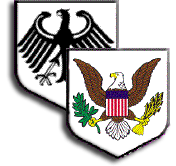Articles and Reviews
Book Review: "The Cincinnati Germans in the Civil War,"
Ohio Civil War Genealogy Journal 15:3(2011): 119.
Cincinnati Germans in the Civil War
Book Notice: The Cincinnati Germans in the Civil War. Gustav Tafel. Edited and translated by Don Heinrich Tolzmann. Milford OH: Little Miami Publishing Company, 2010. 198 pages. $16.95. <littlemiamibooks.com>
The Cincinnati Germans in the Civil War should immediately become an essential book for any research on Germans in Cincinnati in the 19th Century, on Germans in the Civil War, and on Cincinnati in the Civil War. The core of the book is provided by Gustav Tafel, whose close connection to these subjects can be illustrated with the bare facts of his career: born in Munich, immigrated to Cincinnati in 1847, employee at the Cincinnati Gazette, reporter for the Cincinnati Volksblatt, one of the founders of the Cincinnati Turnverein, attorney admitted to the bar in 1858, lieutenant in the all-German 9th Ohio Volunteer Infantry, recruiter and commander of the all-German 106th Ohio Volunteer Infantry, elected to the Ohio State Legislature, mayor of Cincinnati, and important author of German history (e.g., introduction to the regimental history of the 9th OVI, 1881 Der Deutsche Pionier article on the future of German immigrants and descendants in America.)
This book includes the first translation of Tafel’s history of “Cincinnati Germans in the Civil War,” originally published in 1901 as part of a larger, German language history of Germans in Cincinnati, and never before translated into English. The same history provided a biographical sketch of Tafel, also translated by Professor Tolzmann and included in this new book.
Tafel’s history, the translation of which takes forty pages, comes from a clear point of view: “It was generally accepted that the weight of the German vote had tipped the scales in favor of Lincoln, making his election possible. It was also recognized by every unprejudiced citizen that it was the willingness of German-Americans to support the Union cause that played such a decisive role in the lengthy and extremely bloody Civil War, making the final victory possible.” In his article, Tafel summarized the activities of the 9th, 28th, 106th, 108th , 47th, and 165th OVI, all primarily German regiments; other Cincinnati regiments that included significant numbers of Germans (5th, 6th, 10th, 39th, 54th, and 83rd); non-Ohio regiments with Germans from Ohio (32nd Indiana, 1st Kentucky, 2nd Kentucky, and 7th Missouri); Louis Hoffman’s 4th Ohio Independent Battery of Light Artillery; and the 4th and 5th Ohio Volunteer Cavalry regiments, both with “many Germans.” Some of the information included is not widely known today, such as the important background that Louis Hoffman’s service under Franz Sigel during the 1848 revolution in Baden was critical to Hoffman’s recruiting of the battery in Cincinnati in August 1861 that went immediately to Missouri to serve under Sigel (see Question 2011-03, George Siegel, 4th OIBLA, for more information on the battery.)
In addition to translating Tafel’s work, Professor Tolzmann has provided supplemental information on many units and subjects: Lincoln and the Cincinnati Germans, Medal of Honor recipient Hubert Dilger’s Battery I of 1st Ohio Light Artillery, Markgraf’s 8th Independent Battery, the Cincinnati Turnverein and its connections to the Sioux uprising in New Ulm MN in 1862, a chronology of key events in Civil War remembrances, Cincinnati German soldiers of note (Kaemmerling, Kautz, Willich, Alms, Doepke, Hickenlooper, and others), Ohio German units from other areas of the state (7th, 37th, 107th, 58th and 74th OVI, 20th Independent Battery, 3rd OVC), Papa Willich’s famous 32nd Indiana, museums, sites, Memorial Days, and Memorial Halls. His essential endnotes amplify information on people (e.g., Judge Johann Stallo) and events (e.g., Lincoln’s visit to Cincinnati en route to his inauguration), as well as providing references to additional sources, many not often cited in Civil War literature. The text is complemented by unique photographs of Tafel and his war memorabilia provided by the Tafel Family Association, as well as many photographs by the editor of relevant Cincinnati and Hamilton sites.
